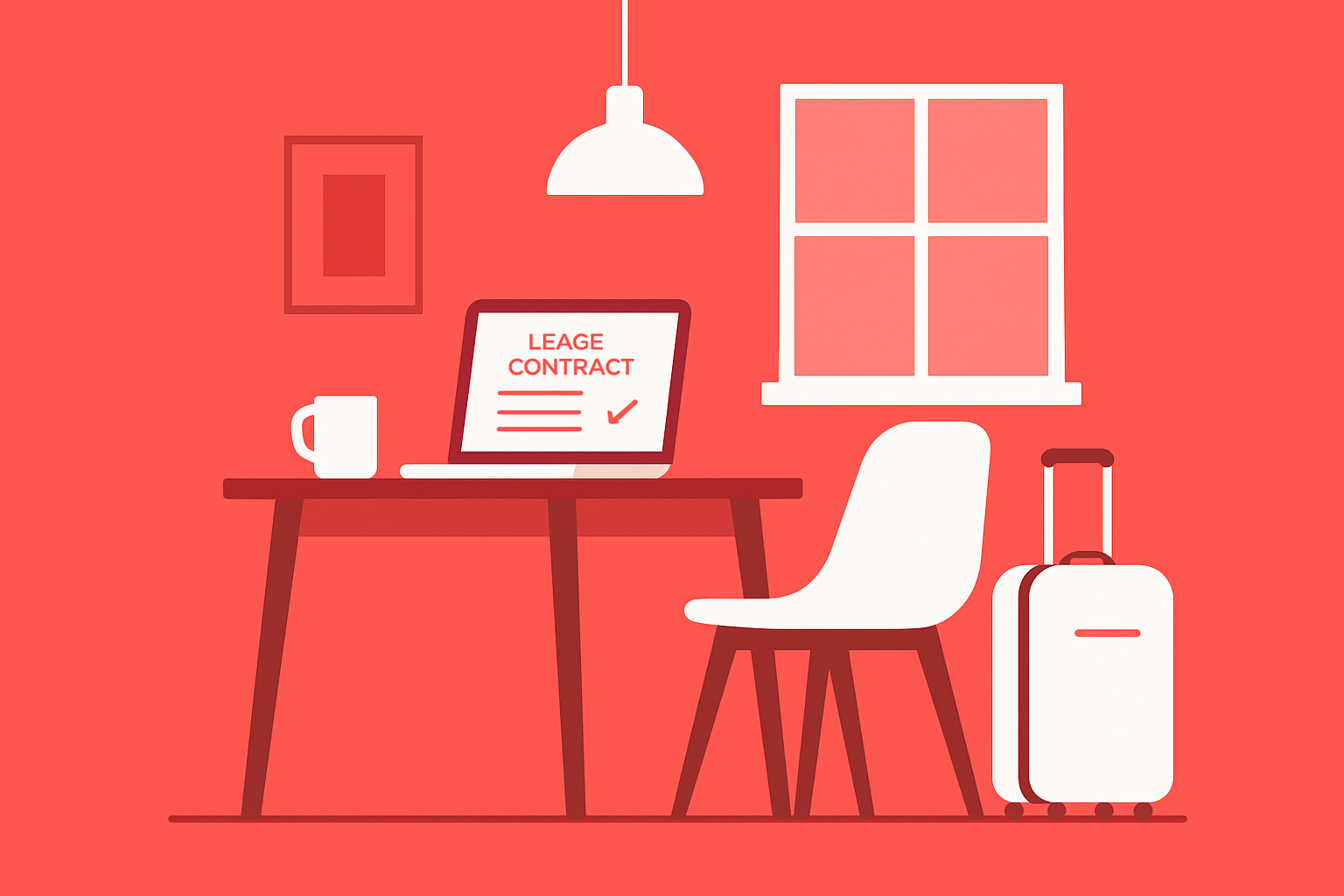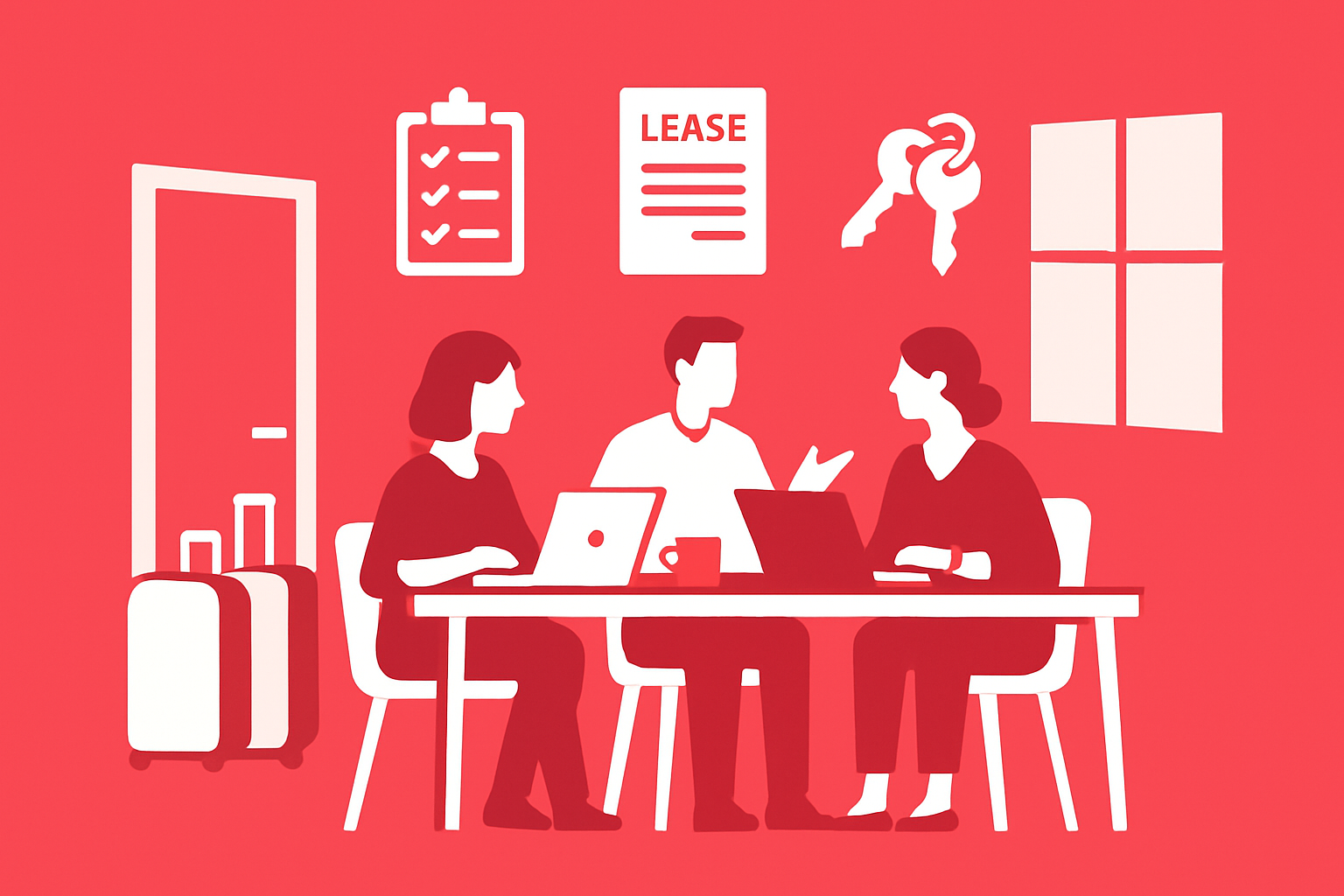|
Getting your Trinity Audio player ready...
|
In today’s fast-moving business world, choosing the right workspace can make or break your company’s success. The stakes are high, and the decisions around corporate leases are more complex than ever.
This guide is designed to demystify corporate leases for businesses planning ahead into 2025. You’ll get clear, actionable insights to navigate changing lease structures, understand key legal and financial considerations, and spot new trends shaping the market.
Whether you’re a startup leader or managing a large enterprise, use this resource to make confident choices and secure the best possible lease for your business needs.
Understanding Corporate Leases: Fundamentals & Key Terms
Securing the right workspace starts with understanding the basics. Corporate leases are at the heart of many business operations, yet they differ significantly from standard commercial agreements. For decision-makers, knowing the essentials is the first step toward smarter, more cost-effective choices.

What Are Corporate Leases?
Corporate leases are specialized agreements between businesses and property owners, designed to meet organizational needs rather than individual tenants. Unlike traditional commercial leases, which often focus on retail or small business arrangements, corporate leases are tailored for larger-scale operations, flexible project teams, or companies needing multiple units.
If you’re new to this concept, you can find a detailed explanation in What is a corporate lease.
Types of Corporate Leases
There are several common structures for corporate leases. Each comes with its own approach to costs and responsibilities:
- Full-Service Lease: The landlord covers almost all expenses, including utilities and maintenance.
- Net Lease: Tenants pay base rent plus some or all property expenses, such as taxes or insurance.
- Gross Lease: Tenants pay a single, all-inclusive rent amount, with the landlord covering building costs.
- Modified Gross Lease: Costs are shared between landlord and tenant, combining elements of net and gross leases.
Choosing the right structure can impact your total occupancy cost and administrative workload.
Key Terms Explained
Understanding the language of corporate leases is vital for effective negotiations and risk management. Key terms include:
- Rent: The base amount paid monthly or annually.
- Escalation Clause: Outlines how rent may increase over time, often linked to inflation or market rates.
- CAM (Common Area Maintenance): Fees for shared spaces like lobbies, elevators, or parking.
- Security Deposit: Upfront payment to cover potential damages or unpaid rent.
- Lease Term: The duration of the lease, typically ranging from one to ten years.
- Renewal Options: Contract terms allowing tenants to extend the lease.
- Break Clause: Provisions for early termination under agreed conditions.
Mastering these terms helps businesses avoid unexpected costs and maintain greater control over their workspace.
Tenant and Landlord Roles
In corporate leases, both parties have distinct roles. Tenants are usually responsible for maintaining their leased area and adhering to usage policies. Landlords manage the overall building, handle structural repairs, and ensure compliance with safety regulations.
Clear division of duties can prevent disputes and foster stronger working relationships.
Duration and Flexibility
Corporate leases can range from short-term (12 months) to long-term (10 years or more), depending on business needs. Flexibility is increasingly important in 2025, with many agreements now including options for early exit, expansion, or subletting. Companies value these features to adapt quickly to market changes.
Example: Office Lease vs. Project Team Corporate Lease
Consider a standard office lease: a five-year commitment with fixed space and minimal flexibility. In contrast, a corporate lease for a project team might offer a six-month term, furnished spaces, and built-in services—ideal for agile operations or relocating staff.
2024 Lease Data at a Glance
| City | Avg. Lease Length | Avg. Price per m² (EUR) |
|---|---|---|
| Stockholm | 4.2 years | 480 |
| London | 3.8 years | 925 |
| Berlin | 4.5 years | 420 |
Recent trends show companies seeking shorter, more flexible corporate leases to control costs and reduce risk.
Understanding the terminology and structure of corporate leases is not just academic—it’s a practical strategy for smarter business decisions and long-term stability.
The Corporate Lease Process: Step-by-Step Guide
Embarking on the journey of securing corporate leases can feel daunting, but a clear, systematic process helps simplify each stage. By understanding what to expect, businesses can approach leasing with confidence and avoid common pitfalls. Let’s break down the corporate lease process into five actionable steps, ensuring your business is set up for success.

Step 1: Assessing Business Needs
The first critical step in securing corporate leases is a thoughtful assessment of your business’s unique requirements. Start by evaluating the current headcount and forecasting future growth. Consider how teams collaborate—do you need open-plan spaces, private offices, or a mix?
Location is often the top priority, with 68% of businesses ranking it as the leading factor when choosing corporate leases, according to the 2025 Americas Office Occupier Sentiment Survey. Proximity to clients, access to talent pools, and transportation links all play a role.
For example, a tech startup may prioritize flexibility and creative zones, while a multinational project team might need multiple meeting rooms and a central location. Carefully matching your needs to potential spaces is foundational to a successful corporate lease.
Step 2: Market Research & Shortlisting Properties
Once you’ve outlined your needs, the next step in the corporate leases process is conducting thorough market research. Utilize commercial real estate brokers, reputable online platforms, and direct outreach to landlords. Compare available properties based on amenities, sustainability features, and compliance with accessibility standards.
Modern coworking spaces offer flexibility and a collaborative atmosphere, while traditional office towers may provide prestige and stability. In 2025, “green leases” are increasingly popular, allowing businesses to align space with environmental goals.
Shortlisting suitable properties ensures you only pursue corporate leases that truly fit your business, saving time and resources in later stages.
Step 3: Lease Negotiation Strategies
Negotiation is where strong preparation pays off in the corporate leases process. Begin with a checklist:
| Negotiation Checklist | Importance |
|---|---|
| Rent abatement | Cost savings |
| Fit-out contributions | Customization |
| Flexibility clauses | Future-proof |
| Service charge caps | Budget control |
| Break clauses | Flexibility |
Focus on negotiating rent abatement, fit-out allowances, and flexibility clauses tailored to your needs. Professional advisors—including legal, real estate, and financial experts—can be invaluable.
For example, a company that leveraged expert guidance successfully negotiated a 12% reduction in annual rent. Data from JLL shows 82% of companies negotiate at least one term in their corporate leases, highlighting the importance of this phase.
Step 4: Due Diligence & Legal Review
Thorough due diligence is essential before finalizing corporate leases. Carefully review all terms and obligations, watching for hidden fees, ambiguous break clauses, and assignment or subletting restrictions.
Engage legal counsel to identify potential risks and clarify responsibilities. Overlooking details can lead to costly disputes. For instance, a vague break clause once triggered a real-world dispute, resulting in unexpected penalties for the tenant.
By taking time for legal review, businesses can sign corporate leases with confidence, knowing risks are minimized.
Step 5: Signing & Occupancy Preparation
After negotiation and legal review, it’s time to finalize documentation and prepare for occupancy. Ensure all approvals are secured and lease documents are thoroughly checked before signing corporate leases.
Coordinate move-in logistics—plan IT setup, furniture installation, and compliance checks well in advance. Transition planning is vital: communicate timelines with staff and ensure continuity of operations.
For example, a 50-person team can achieve a seamless transition by mapping out a clear move-in schedule and delegating tasks. By prioritizing communication and preparation, businesses can unlock the full benefits of corporate leases from day one.
Key Legal and Financial Considerations in 2025
Navigating corporate leases in 2025 requires a clear understanding of the legal frameworks that govern these agreements. Across Europe and globally, regulations are evolving to address new business realities. Lease agreements now often reflect updated civil codes, commercial property laws, and international standards. Businesses must stay alert to changes in lease regulations, data privacy, and health and safety requirements. For a deeper dive into current legal trends and negotiation strategies, consult Leasing Trends in Commercial Real Estate.

A major shift in corporate leases for 2025 is the rise of ESG (Environmental, Social, Governance) and accessibility compliance. Landlords and tenants alike face new obligations to ensure buildings meet sustainability standards and are accessible for all employees. For example, in Sweden and Germany, ESG clauses are now standard in most lease negotiations. These clauses require tenants to support energy efficiency, recycling, and wellness initiatives. According to Savills, 47% of new leases in 2024 included sustainability requirements, highlighting the growing importance of these considerations.
| Compliance Area | Typical Requirements (2025) |
|---|---|
| Environmental (E) | Energy efficiency, green materials |
| Social (S) | Accessibility, wellness features |
| Governance (G) | Transparent reporting, data privacy |
Financial planning is essential when entering corporate leases. Beyond base rent, businesses must budget for deposits, service charges, maintenance, and unexpected costs like repairs or compliance upgrades. A well-structured lease will outline escalation clauses and caps on shared expenses, helping companies maintain cost control. For project teams or multinational operations, variable costs can quickly impact the bottom line if not managed proactively.
Tax implications are another crucial element in the landscape of corporate leases. Rent payments, fit-out contributions, and maintenance expenses may be tax-deductible, depending on local laws. In some regions, VAT applies to rent or service charges, while others impose local property taxes. Understanding the tax treatment of lease payments can significantly affect budgeting and cash flow. Consulting with a tax advisor is highly recommended before finalizing any lease agreement.
Ultimately, proactive legal and financial review is the best defense against costly disputes and business interruptions. Ambiguous clauses, hidden fees, or unclear break options can lead to conflict down the line. Reviewing all documentation, seeking professional counsel, and staying informed about compliance trends are vital steps. As the landscape of corporate leases continues to evolve, businesses that prioritize due diligence will be best positioned for long-term stability and success.
Negotiating Corporate Leases: Strategies for Success
Navigating the negotiation process for corporate leases in 2025 requires more than a sharp eye for detail. Today’s market is dynamic, with evolving expectations and benchmarks. Whether you’re a startup securing your first space or an established enterprise looking to optimize costs, mastering negotiation strategies is crucial. Let’s break down the key steps to ensure your next corporate leases deliver value, flexibility, and long-term stability.

Understanding Market Trends & Benchmarks
Before entering negotiations, it’s essential to understand current market rates and vacancy levels in your target locations. Research from Colliers shows a 3.2% year-over-year increase in prime office rents across Europe in 2024. Comparing these rates in business hubs like Stockholm, London, and Berlin helps set realistic expectations for corporate leases.
Use industry reports and data platforms to benchmark your offers. For instance, reviewing 2025 Commercial Real Estate Trends can reveal which markets offer better value or incentives. Keeping an eye on vacancy rates, incentives, and demand cycles arms you with facts, not just opinions, when negotiating.
Sample Benchmark Table:
| City | Avg. Prime Rent (€/sqm/month) | YoY Change (%) |
|---|---|---|
| Stockholm | 55 | +4.1 |
| London | 70 | +3.0 |
| Berlin | 45 | +2.8 |
Stay data-driven. This approach strengthens your position and helps you identify unique opportunities in corporate leases.
Maximizing Lease Flexibility
Flexibility is vital for businesses facing uncertain or rapid change. When structuring corporate leases, prioritize clauses that enable adaptation over time. Key options include:
- Break clauses: Allow early exit if business needs shift.
- Renewal options: Secure the right to extend on favorable terms.
- Expansion rights: Ensure room to grow within the building.
- Subletting and assignment: Retain the ability to share or transfer space.
For example, a startup negotiating a 2-year break in a 5-year lease gains security without sacrificing agility. Flexibility also applies to workspace type—consider furnished or serviced options for project teams or temporary needs. Understanding these choices can make corporate leases a strategic asset, not just a cost.
If your company seeks adaptable solutions, exploring corporate housing furnished apartments may offer additional flexibility and comfort, especially for project-based or relocating teams.
Cost-Saving Tactics
Reducing total occupancy costs is a top priority in corporate leases. Start by negotiating for rent-free periods or fit-out allowances. Some landlords offer several months of rent abatement to attract tenants in competitive markets.
Consider capping service charges and requesting contributions toward office improvements. Leverage competition—if multiple properties fit your criteria, use that as a bargaining chip. The rise of hybrid work has shifted the leverage toward tenants in some markets, as landlords seek to fill vacant space.
Example Table: Cost-Saving Opportunities
| Tactic | Potential Savings |
|---|---|
| Rent-free period | 1–3 months' rent |
| Service charge cap | €30,000+/year |
| Fit-out allowance | Up to €150/sqm |
By combining these tactics, even a mid-sized company can save thousands annually on corporate leases.
Building Strong Landlord-Tenant Relationships
Negotiation isn’t just about the contract—it sets the tone for your landlord relationship. Open, transparent communication builds trust and ensures smoother operations. Clarify maintenance responsibilities, reporting procedures, and dispute resolution methods from the outset.
Proactive engagement can lead to long-term benefits. For example, when a tenant and landlord collaborate on upgrades or sustainability initiatives, renewals and concessions often follow. A positive relationship transforms corporate leases from transactional to strategic, supporting your business’s long-term goals.
Ultimately, investing time in relationship-building can yield smoother lease renewals and fewer surprises throughout your tenancy.
Corporate Lease Trends & Innovations for 2025
The world of corporate leases is undergoing a seismic shift in 2025. Companies are reimagining their relationship with office space, driven by changing work patterns, sustainability demands, and rapid tech adoption. These trends are reshaping how businesses approach corporate leases, making flexibility and innovation the new norm.
Flexible Workspace Solutions
Businesses are increasingly opting for flexible workspace options over traditional corporate leases. Serviced offices, coworking spaces, and temporary corporate apartments are now mainstream, catering to project-based teams and companies scaling at speed. This shift is fueled by the need for agility—why commit to a long-term lease when you can scale up or down as needed?
Corporate homes and serviced apartments also provide a compelling alternative, offering fully equipped spaces in prime locations. These solutions are especially valuable for teams needing mid-term stays or relocating staff. For more on this trend, see corporate homes for business stays, which explores how alternative workspace models are meeting modern business needs.
Remote/Hybrid Work’s Impact
Remote and hybrid work models are fundamentally altering corporate leases. With 59% of companies planning to reduce their office footprint by 2025 (Knight Frank), demand for smaller, more adaptable spaces is rising. This means shorter lease terms, modular layouts, and shared amenities are now key criteria.
Companies are prioritizing locations that support both in-office collaboration and remote connectivity. The result? Corporate leases are more likely to include access to high-speed internet, flexible meeting rooms, and wellness spaces that attract top talent.
Sustainability & Smart Building Innovations
Sustainability is no longer optional in corporate leases. Green leases—agreements that include environmental and wellness commitments—are on the rise, especially in Sweden, Germany, and the UK. Features like energy-efficient lighting, waste reduction programs, and indoor air quality monitoring are becoming standard.
Smart building technology is also transforming the market. IoT-enabled facilities can track energy use, automate climate control, and offer smart access systems. These innovations not only reduce costs but align with corporate ESG goals, making them a must-have in new lease negotiations.
Technology Innovations
Digital transformation is at the heart of modern corporate leases. AI-powered lease management platforms simplify everything from contract negotiation to compliance tracking. Digital contract platforms enable secure, remote signing—accelerating deal timelines and reducing paperwork.
IoT solutions allow businesses to monitor occupancy and optimize space usage in real time. For example, a corporate lease might now include integrated smart access and energy monitoring, offering both convenience and cost savings.
Regional & Future Trends
Europe’s business hubs are leading in green lease adoption. In Stockholm, London, and Berlin, landlords are competing on sustainability features and digital amenities. According to the 2025 U.S. Real Estate Market Outlook Midyear Review, companies worldwide are leveraging data analytics to benchmark lease terms and anticipate future needs.
Here's a quick snapshot of key trends:
| Trend/Innovation | 2025 Impact on Corporate Leases |
|---|---|
| Flexible workspaces | More short-term, scalable leases |
| Remote/hybrid work | Smaller footprints, modular layouts |
| Sustainability/green leases | ESG clauses and wellness features |
| Smart tech & IoT | Automated access, energy management |
| Digital contracts | Faster, paperless lease transactions |
As the landscape continues to evolve, staying ahead of corporate lease trends will be crucial for business success. By embracing innovation and flexibility, companies can secure spaces that support growth, talent, and sustainability—all while optimizing costs and reducing risk.
Now that you know what goes into a successful corporate lease—and how crucial the right housing choice is for your team’s productivity and peace of mind—why not see what’s possible? At Guestly Homes, we take the hassle out of finding premium, flexible accommodations for business travel, extended projects, or relocations across Sweden. If you want your team to feel at home and stay focused on what matters most, take the next step and See Available Homes. You might just find the perfect fit for your business’s needs.


